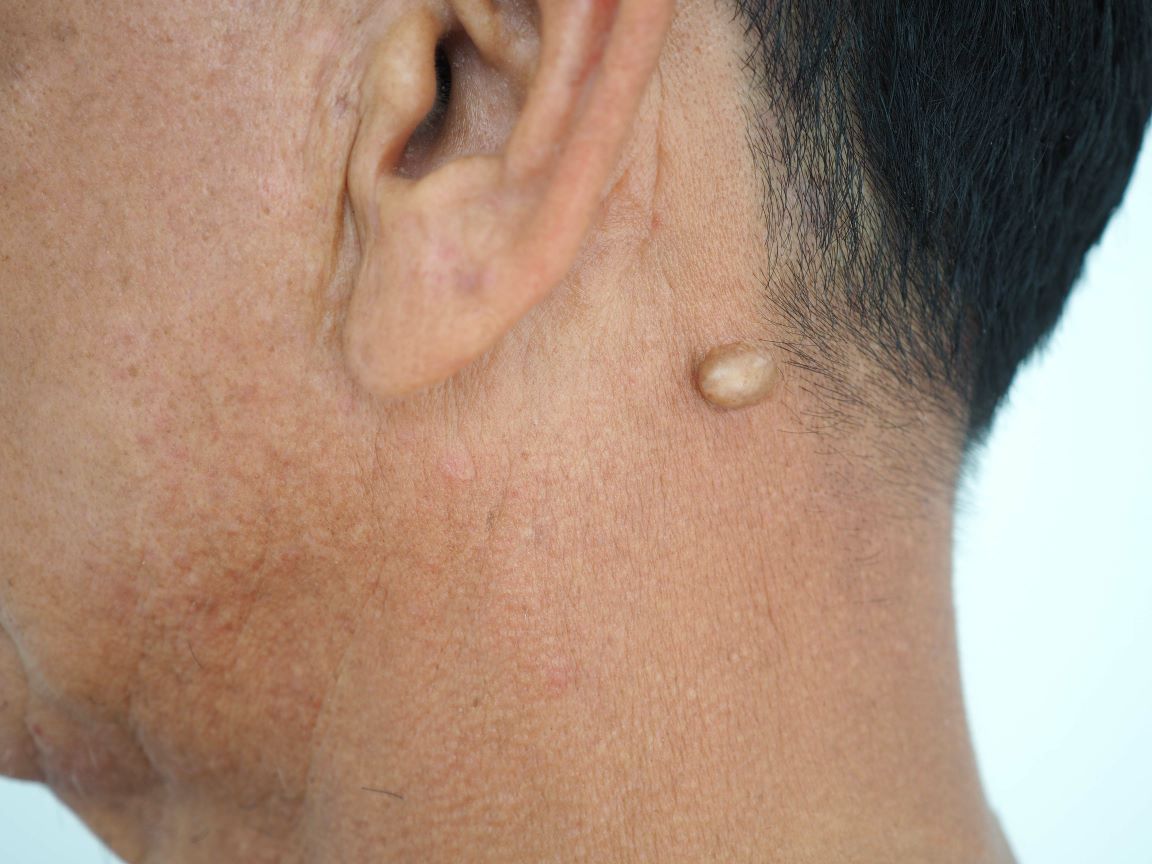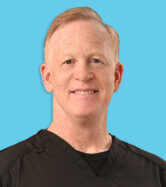Cysts are a relatively common skin concern that can develop all over the body, and in many cases, they are completely painless and benign. However, without treatment, cysts may become very large, infected, or inflamed. When this happens, you should visit a dermatologist to explore treatment options. According to Dr. Drew Reese of U.S. Dermatology Partners in Goodyear, Arizona, “Cysts that are painful or very large need to be treated. Many people try to pop their cysts, but this is a very bad idea. Best case scenario, the cyst will refill after it’s popped. Worst case scenario, the cyst can become infected. It’s always best to consult with a dermatologist to receive appropriate treatment for cysts.” In this blog, Dr. Reese discusses what cysts are, why they form, and most importantly, how they’re treated.
Understanding Cysts: More Than Just a Bump
Cysts are skin growths made up of a sac (enclosed membrane within the skin) that fills with fluids, skin cells, hair, bacteria, and other materials. A newly formed cyst may feel like a pea trapped beneath the skin. However, they can fill with additional matter and grow larger. In most cases, cysts are benign (non-cancerous), painless, and slow-growing. Unless they become infected or otherwise interfere with daily life, cysts may not even need to be treated. A dermatologist will examine your cyst and help you decide whether treatment is needed.
The Different Types of Cysts
Some of the most common types of cysts include:
- Cystic acne – a painful, difficult-to-treat type of acne that forms deep in the skin unlike traditional types of acne that develop on the surface of skin. More advanced dermatologic treatments are often necessary to clear up cystic acne.
- Epidermoid cysts – occur when the outer layer of skin (epidermis) isn’t shed away. Instead, the dead skin cells fill the cyst sac.
- Ganglion cysts – these cysts form in the joints of the hands and feet. They aren’t usually painful. However, if they grow too large, they may be removed, so the cyst doesn’t limit movement.
- Pilonidal cysts – this is a cyst that typically forms around an ingrown hair on the upper buttock or tailbone. Due to the location, these cysts are prone to infection, and they typically need to be removed by a dermatologist.
- Pilar cysts – these cysts most often form within hair follicles on the scalp. They fill with keratin, creating hard growths in the scalp.
- Sebaceous cysts – the body’s natural oil, sebum, is produced within the sebaceous glands. When these glands become blocked, a sebaceous cyst can form. In most cases, these cysts are filled with sebum oil.
Causes of Cysts: Why Do They Form?
The underlying causes of cysts vary. Dr. Reese explains, “Anyone can develop a cyst. They are often caused by infection or in response to a foreign object in the body. Infection may occur after a minor injury or clogged pore, a cyst sac forms and fills. Inflammation may occur when a foreign object like a piercing is placed. The body attempts to protect itself, and a cyst is formed around the object. During your consultation, a dermatologist will examine your cyst carefully and determine the underlying cause of the cyst to ensure the best treatment and help you prevent the formation of more cysts.”
Professional Treatment Options
When it comes to treatment, Dr. Reese says, “Any treatment should be performed at the recommendation of a dermatologist. They have the proper tools and knowledge to ensure treatment is safe and effective.” A dermatologist will provide a personalized treatment plan for you, but some of the common options to treat cysts include:
- Drainage – removing the fluid inside the cyst can alleviate discomfort and shrink the cyst.
- Cortisone injections – this treatment shrinks the cyst down without the need for more invasive extractions or drainage. Cortisone injections may be a good option for smaller cysts or to alleviate discomfort for people who develop cysts frequently, including those with cystic acne.
- Antibiotics – if cysts become infected, oral or topical antibiotics will be prescribed to address the infection and improve healing.
- Surgical excision – because cysts are encased in a sac, there is always a risk that the cyst will refill if the sac is not removed. Surgical excision drains away the material inside the cyst and fully removes the sac to prevent regrowth.
Why You Should Consult a Dermatologist
There are many different kinds of cysts, and all of them should be treated in partnership with a dermatologist. However, this may be even more important for cysts. Dr. Reese says, “Cysts that grow large enough to cause discomfort are at high risk for infection. Popping these cysts can cause infected fluids to seep out onto the skin and spread the infection. Attempting to pop a cyst can also push the fluid out of the sac deeper into pores and surrounding tissues. This can spread infection under the skin, which is even more difficult to treat. Perhaps most importantly, even if you manage to pop a cyst, it will likely refill if the entire sac isn’t removed. A dermatologist can safely remove the entire cyst material and sac to ensure the cyst is completely removed, and it won’t be back to haunt you.”
Some types of cysts will clear up on their own, but even if you think the cyst will go away, you may want to consider visiting a dermatologist for a variety of reasons, including:
- Preventing infection
- Alleviating pain
- Improving appearance
- Allowing for a full range of comfortable movement
- Restoring blood flow
- Relieving pressure on nerves
Home Remedies: What Works and What Doesn’t
According to Dr. Reese, “The vast majority of home remedies for cysts simply don’t work. Some of them provide a bit of relief from pain until you get in to see your dermatologist, but for the most part, they will not clear up the cyst. However, most of these home remedies also don’t cause additional damage, so if they offer symptom relief, they are okay to use. However, your best bet is just to keep the area clean and schedule a consultation with your dermatologist. It is never a good idea to pop your cyst as this may allow infection to spread or force the infection deeper into the skin, making it more difficult to treat.” While most at-home remedies won’t work to address cysts long-term, some options that provide short-term relief until your dermatologist visit include:
- Warm compresses – apply a warm compress to the cyst for about 20 minutes a few times a day. This increases blood circulation, which can speed healing. Infected cysts may also be brought to a head by applying warm compresses, but this can take several days of consistent application. Even if the cyst begins to drain on its own, professional extraction is still required to prevent the cyst from refilling.
- Cold compresses – apply cold compresses to a cyst that is very painful, red, and inflamed. A warm compress stimulates circulation to prompt healing, but a cold compress numbs the area to alleviate pain. It may be a good idea to apply the cold compress for about 20 minutes just before bed.
- Bandage cysts – if the cyst is draining, make sure to apply a clean, sanitary bandage to the area to absorb any draining material. Change the bandage at least daily or as frequently as needed.
- Good at-home care – the most important skincare practice is cleansing. Carefully wash the cyst with gentle soap and water. Rinse thoroughly to ensure no residue is left behind. If the cyst is very painful and even cleaning causes discomfort, consider using the EltaMD Dermal Wound Cleanser. This cleanser is sprayed directly onto the cyst, rubbed over the area in gentle circles, and allowed to dry.
- Other home remedies – applying ingredients like tea tree oil, apple cider vinegar, honey, and aloe vera to cysts have not been found effective in clinical studies. However, these ingredients have a long history of being used for medicinal purposes, and many people report experiencing relief when utilizing these products. If you experience relief from using one of these home remedies, they are usually considered safe, but it’s always best to consult with a dermatologist.
Always Talk to a Professional First
While so-called pimple-popping videos online encourage people to perform cyst and blemish extractions at home, this really isn’t a good idea. Cysts can cause a range of issues if they are improperly removed. Infection can occur, and without removing the sac, the cyst will just refill over time. This means you’ll need to drain the cyst repeatedly. A dermatologist can carefully examine the cyst and provide an effective treatment plan to safely and completely remove your cyst.
Get Started Working with U.S. Dermatology Partners Today
If you notice a lump or bump that you believe is a cyst, don’t hesitate to reach out to the U.S. Dermatology Partners team to schedule a consultation with one of our board-certified dermatologists. They’ll be happy to examine the area and provide safe, effective cyst treatment recommendations. When you’re ready to get started working with our team, simply take a few moments to complete our online scheduling form. Once received, a local dermatology team member will reach out to finalize the details of your upcoming consultation.
Find a location near me
or


